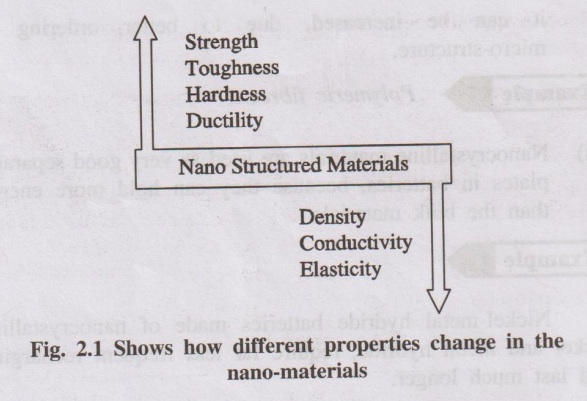Engineering Chemistry: Unit II: Nanochemistry
Size Dependent Properties of Nanomaterials
Nanomaterials are composed of grains and grain boundaries. Nanometre sized grains contains only a few thousands of atoms with in each grain.
SIZE DEPENDENT
PROPERTIES
Nearly all the properties as shown in figure 2.1, like hardness,
strength, ductility, melting point and density, change for nanomaterials. These
behaviors vary so significantly by a mere reduction in grain size.
Nanomaterials are composed of grains and grain boundaries. Nanometre sized
grains contains only a few thousands of atoms with in each grain.

Fig. 2.1 Shows how
different properties change in the nano-materials
A large number of atoms reside at the grain boundaries. As the
grain size decreases, there is a significant increase in the volume fraction of
grain boundaries or interfaces.
The properties of the materials are bound to be governed to a
large extent by defect configurations. Hence the mechanical and chemical
properties of nanomaterials are significantly altered due to defect dynamics.
The elastic property of nanomaterials are different from that of bulk alloys
due to the presence of increased fraction of defects.
Examples
1. Nanocrystalline ceramics are tougher and stronger than those with coarse grains.
2. Nano-sized metals exhibit significant decrease in toughness and yield strength increases.
1. Important Properties of Nanomaterials
1. Electrical Properties
(i) Electrical conductivity decreases with a reduced dimension due
to increased surface scattering. However,
it can be increased, due to better ordering in micro-structure.
Example : Polymeric fibres.
(ii) Nanocrystalline materials are used as very good separator plates
in batteries, because they can hold more energy than the bulk materials.
Example
Nickel-metal hydride batteries made of nanocrystalline nickel and
metal hydride, require far less frequent recharging and last much longer.
2. Optical Properties
Reduction of material dimensions has pronounced effects on the
optical properties. Optical properties of nano-materials are different from
bulk forms.
The change in optical properties is caused by two factors
(i) The quantum confinement of electrons within nano-particles
increases the energy level spacing.
Example
The optical absorption peak of a semiconductor nano-particles
shifts to a short wavelength, due to an increased band gap.
(ii) Surface plasma resonance, which is due to smaller size of
nano-particles than the wavelength of incident radiation.
Example
The colour of metallic nano-particles may change with their sizes
due to surface plasma resonance.
3. Mechanical
properties
The nano-materials have less defects compared to bulk materials,
which increases the mechanical strength.
(i) Mechanical properties of polymeric materials can be increased
by the addition of nano-fillers.
(ii) As nano-materials are stronger, harder and more wear
resistant and corrosion resistant, they are used in spark plugs.
Example
Nano-crystalline carbides are much stronger, harder and wear
resistant and are used in micro drills.
4. Magnetic properties
Magnetic properties of nano materials are different from that of
bulk materials. Ferro-magnetic behaviour of bulk materials disappear, when the
particle size is reduced and transfers to super-paramagnetics. This is due to
the huge surface area.
Engineering Chemistry: Unit II: Nanochemistry : Tag: Engineering Chemistry : - Size Dependent Properties of Nanomaterials
Related Topics
Related Subjects
Engineering Chemistry
CY3151 1st Semester | 2021 Regulation | 1st Semester Common to all Dept 2021 Regulation
